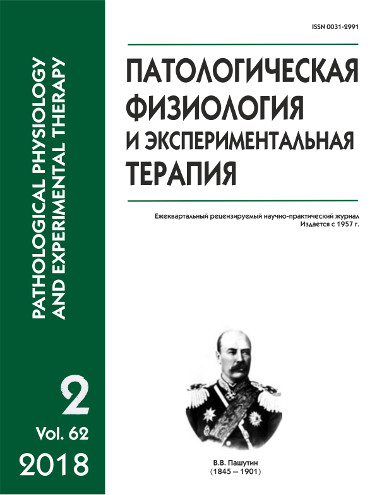Hypoglycemic properties of pectine from pumpkin (Cucurbita maxima d.) in a model of alloxan-induced type 1 diabete mellitus
Abstract
Hyperglycemia is a biochemically defined initial symptom of diabetes and its serious complications (atherosclerosis, retinopathy, kidney damage). Pectins are currently considered as novel plant-produced hypoglycemic agents. The aim of this study was to evaluate bio-functional properties of pumpkin pectin obtained from pumpkin pulp using cavitation-membrane technologies in a model of alloxan-induced diabetes. Methods. Male Wistar rats were used in the experiments. Diabetes was modeled by injections of 4.3% alloxan monohydrate solution. The development of diabetes was confirmed by glucose concentration in peripheral blood (glucose levels of >
Downloads
References
2. Babbar N., Dejonghe W., Gatti M., Sforza S., Kathy E. Pectic oligosaccharides from agricultural by-products: production, characterization and health benefits. Crit. Rev. Biotechnol. 2016; 36(4): 594-606.
3. Parkar S.G., Redgate E.L., Wibisono R., Luo X., E.T.H. Koh, Schröder R. Gut health benefits of kiwifruit pectins: Comparison with commercial functional polysaccharides. Journal of Functional Foods. 2010; 2(3): 210-18.
4. Ghaffarzadegan T., Marungruang N., Fåk F., Nyman M. Molecular properties of guar gum and pectin modify cecal bile acids, microbiota, and plasma lipopolysaccharide-binding protein in rats. PLoS ONE. 2016; 1-18.
5. Rubio-Senent F., Rodríguez-Gutiérrez G., Lama-Muñoz A., Fernandez-Bolaños J. Pectin extracted from thermally treated olive oil by-products: Characterization, physico-chemical properties, in vitro bile acid and glucose binding. Food Hydrocolloids. 2015; 43: 311-21.
6. Nosaľova G., Prisenznakova Ľ., Kosalova Z., Ebringerová A., Hromadkova Z. Suppressive effect of pectic polysaccharides from Cucurbita pepo L. var. Styriaca on citric acid-induced cough reflex in guinea pigs. Fitoterapia. 2011; 82(3): 357–64.
7. Holck J., Hjernø K., Lorentzen A., K.L. Vigsnæs, Hemmingsen L., Licht T.R., Mikkelsen J.D., Meyer A.S. Tailored enzymatic production of oligosaccharides from sugar beet pectin and evidence of differential effects of a single DP chain length difference on human faecal microbiota composition after in vitro fermentation. Process Biochemistry. 2011; 46(5): 1039–49.
8. Lisickaya K.V., Torkova A.A., Nikolaev I.V., Fedorova T.V., Mihaleva M.A., Koroleva O.V. Comparative analysis of the antioxidant properties of pectins from different plant raw materials on model cellular systems. Pishhevaja promyshlennost'. 2012; 12: 64-7. (in Russian)
9. Etuk E.U. Animal models for studying diabetes mellitus. Agiculture Biol. J. North Am. 2010; 1: 130-4.
10. Rohilla A. Alloxan induced diabetes: mechanisms and effects. Int. J. Res, Pharm. Biomed. Sci. 2012; 3: 819-23.
11. Gomathy R., Vijayalekshmi N.R., Kurup P.A. Hypoglycemic action of the pectin present in the juice of the inflorescence stalk of plantain (Musa sapientum) - Mechanism of action. J. Biosci. 1990; 15: 297-303.
12. Barbalho S.M., de Souza M.S.S., de Paula e Silva J.C., Mendes C.G., de Oliveira G.A., Costa T., Farinazzi-Machado F.M.V. Yellow passion fruit rind (Passiflora edulis): an industrial waste or an adjuvant in the maintenance of glycemia and prevention of dyslipidemia? J. Diabetes Res. & Clin. Metabol. 2012; 1: 1-4.
13. Mihara M., Uchiyama M., Fukuzawa K. Thiobarbituric acid value on fresh homogenate of rat as a parameter of lipid peroxidation in aging, CCl4 intoxication, and vitamin E deficiency. Biochemical Medicine. 1980; 23(3): 302-11.
14. Ou B., Hampsch-Woodill M., Prior R.L. Development and validation of an improved oxygen radical absorbance capacity assay using fluorescein as the fluorescent probe. J. Agric. Food Chem. 2001; 49: 4619–26.
15. Folch J., Lees M., Sloane Stanley G.H. A simple method for the isolation and purification of total lipids from animal tissues. Journal of Biological Chemistry. 1957; 226: 497-509.
16. Zhang Z.-P., Tian Y.-H., Li R., Cheng X.-Q., Guo S.-M., Zhang J.-X., Wang J.-J., Hu L. The comparison of the normal blood biochemical values of Wistar rats with different age and sex. Asian J. Drug Metabol. Pharmacokinet. 2004; 4: 215.
17. Cohen, B. Explaining psychological statistics (3rd ed.). New York: John Wiley & Sons. 2008.
18. Papathanasopoulos A., Camilleri M. Dietary Fiber Supplements: Effects in Obesity and Metabolic Syndrome and Relationship to Gastrointestinal Functions. Gastroenterology. 2010; 138: 65–72.
19. Tin'kov A.A., Gatiatulina E.R., Popova E.V., Polyakova V.S., Skal'naya A.A., Agletdinov E.F., Nikonorov A.A., Radysh I.V., Karganov M.Yu., Skal'nyj A.V. Influence of adipogenic diet at an early age on the content of trace elements in the tissues of rats. Patologicheskaya Fiziologiya i Eksperimental’naya terapiya. 2016; 60(4): 79-85. (in Russian)
20. Kuz'menko D.I., Udincev S.N., Kliment'eva T.K., Serebrov V.Yu. Oxidative stress of adipose tissue as the primary link in the pathogenesis of insulin resistance. Biomeditsinskaya khimiya. 2016; 62(1): 14-21. (in Russian)
21. Park K.S., Ciaraldi T.P., Lindgren K. et al. Troglitazone effects on gene expression in human skeletal muscle of type II diabetes involve up-regulation of peroxisome proliferator-activated receptor-gamma. J. Clin. Endocrinol. Metab. 1998; 83: 2830–5.






